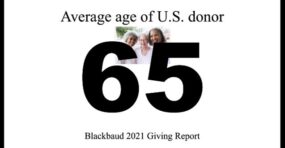The following is a hand-picked guest post from Tom Ahern. Enjoy, and you can read more about Tom below.
* * *
“We need younger donors!” Yes? No? Ummmm…?
What could possibly go wrong?
Three factors to consider: (1) most giving in the US comes from older people (for a mundane reason that co-exists with, but is not driven by, compassion); (2) charity leadership might not be aware of this; (3) have you heard of Dr. Ken Dychtwald?
——
Who gives (really)?
This is American data… and I don’t mean to be US-centric. But it doesn’t shift all that much across the English-speaking world, is my understanding. I’ve been loosely tracking it (via real experts) for more than 2 decades.

All I want is a solid mountain of data to climb… and Blackbaud has one.
What you often hear from well-meaning, really-trying-to-be-helpful board members, bosses, program staff and others is this:
“We NEED younger donors!”
Sounds like a reasonable strategy?
Or IS it? (Cue dramatic music.)
To my flimsy knowledge (raise your hand if, like me, you’re NOT a credentialed researcher): NO.
Au contraire: it’s an untutored, uneconomic, unrealistic, ill-advised strategy. A bright idea. A pillow dream. A “just add water” solution that sounds good until a charity attempts to execute it and meet its budget.
Dear sensible nonprofits…
There’s a sound economic reason you SHOULD chase OLDER donors: it’s about the money.
People AGE into their PRIME giving years.
Those donors who will prove most lucrative AGE into their “Now, I have more disposable income to give away” years.
That happy life-event happens around age 55, after other big-ticket items have been bought. According to the Wall Street Journal in 2022, “it now costs $300,000 to raise a child” through high school graduation.
Around 55, those who are “philanthropically-inclined” can START to give more to their favorite charities.
NOW… at long last… hallelujah [skip the ads]… these age 55+ individuals / households finally have enough extra income to throw at beloved good causes, the ones their hearts always yearned to support.
——
Who’s Dr. Dychtwald?
Here’s a 2022 YouTube intro to psychologist and futurist Ken Dychtwald’s studies and conclusions. It’s about 5.5 minutes long. And, trust me, it will BLOW YOUR MIND (to revert to the phrasing of my youth).
His last name is pronounced “Dyke Wald,” BTW. And I want to thank Sallie Mitchell for reminding me of his insights and wisdom. She’s worked with Ken. And Sallie’s always been an enviable over-achiever “who gets sh*t done.”
When you’re younger, you’re building your life.
Except for some dot.com baby millionaires, you’re likely spending what you’re earning.
Of course, you’re intrinsically generous.
Maybe you were brought up that way. Maybe it’s baked into your core values. After all… major faiths around the planet command that you help others who are worse off.
So you WANT to help.
You CRAVE helping. Maybe you have passion and some time to spare, so you volunteer.
But surplus cash for young adults can be lean… and far between. I fed on food stamps for a decade after I hauled in my MA from an Ivy League school. I was white (privilege). I was male (privilege). I had parents who insisted I get a college education (privilege). And I was broke.
Eventually, lucky me, all that unearned privilege worked in my favor. Today is different than then. I escaped curbside doom. To my shock, I’m no longer poor. Destitute. Abandoned. Lucky me. Thanks to SO many others. I’m VERY lucky…
One more time: you – blessed, lovingly privileged – age into your prime giving years.
You become a force for good.
THE UN-BITTER TRUTH: Many people are generous beyond all reason… at all ages.
But until you have surplus income (after you’ve bought and built your life), you probably can’t give away all that much.
That happens around age 55, experts like Jeff Brooks concur.
——
STILL not convinced?
IF you’re buying the coffee (though I’d prefer cocktails) – I’m delighted to explain in greater detail (with PowerPoint and a dump-truck of world-sourced evidence) the undeniable economic realities re: why younger donors are not the Grail, the Golden Goose, the Miracle Whip, the Lottery, the Secret Sauce, the donor Magic, my father’s Leprechaun (he had one), nor the Easy Solution.
Fundraising is hard.
Don’t trust anyone peddling a glib financial solution like, “We need younger donors.”
At least not on the assumption that a donor acquired in her 20s will still be giving to the same causes in her 70s (the CDC’s birth-to-death lifespan is currently 76 years).
Why?
Because the average donor to the average charity doesn’t stick around that long.
Sure, some truest of true believers give for 30 years and even in their wills.
But… most give to a new-to-them charity for something like 4-6 years at best (annual donors) or 4-8 years at best (monthly donors), according to a poll I ran past top agencies globally.
All those agencies are data geeks. They hemmed and hawed. But in the end they confessed that most new donors do not stick around that long… and that’s WHEN you’re doing a GREAT job of donor cultivation (which few charities do).
Here’s the biggest kick in the pants for many charities: MOST (7-to-8 out of 10) FIRST-time donors do NOT make a SECOND gift. (Which is another great reason to promote monthly giving: it automatically cures that “second gift” collapse.)
To harp (I’m of Irish descent; I have the right; we all have harps): Fundraising is hard.
There are no easy solutions. Guessing doesn’t help at all. Know the data. Know what you’re up against.
Here are three data sources I lean on year after year, to set expectations for myself and clients (some unicorns were killed [or at least made tearful] in the making of this reality check):
Blackbaud Institute (a vast donor sample)
Giving USA (what’s happening in America)
M+R Benchmarks (digital/online fundraising)
* * *
Steven says, “Tom Ahern was described by the New York Times as “…one of the country’s most sought-after creators of fundraising messages.” Tom has what I’d call the industry-leading newsletter about fundraising. Being mentioned in it was a career highlight for me. You can (and should!) subscribe for free here.”









